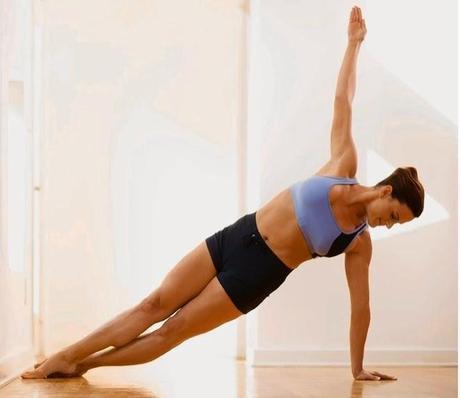
Side Plank Pose (photo "borrowed" from Wall Street Journal)
I’ve been hearing for some time that a single yoga pose, Side Plank pose (Vasithasana), is particularly beneficial for people with scoliosis (see Friday Q&A: Scoliosis). In my post Late-Onset Scoliosis is Common in Older Adults, I wrote about a New York Times article that said that late-onset scoliosis, a condition I have myself, is actually more prevalent in adults than it is in adolescents. The author of that article, Jane Brody, is not a regular yoga practitioner, but she described a “yoga exercise” that was recommended to her after she found out about her late-onset scoliosis."Determined to minimize further shrinkage and to avoid pain and nerve damage, I consulted a physiatrist who, after reviewing X-rays of my misshapen spine, said the muscles on my right side, where the spinal protrusion is, were overdeveloped relative to the left. He prescribed a yoga exercise — a side plank — to strengthen the muscles on the left and exert enough of a tug on my spine to keep it from protruding farther to the right. He suggested that the exercise might even straighten the curve somewhat. And I myself had the same pose, Side Plank pose (Vasithasana) recommended to me by my chiropractor (yes, I have a chiropractor for my scoliosis—I don’t believe that yoga is the answer to everything), so I have incorporated this wonderful strengthening pose into my regular yoga practice."
Now a recent scientific study, which was reported in the Wall Street Journal article Study: Doing the Side Plank Reduced Spinal Curving in Scoliosis Patients, found that for a small group of patients with scoliosis (21 women and four men ages 14 to 85) practicing this one pose resulted in a curve reduction of almost 50 percent among teenage practitioners and 38 percent for adults. Yes, they studied just this single yoga pose!
"In this study, we assess the possible benefits of asymmetrical strengthening of truncal muscles on the convex side of the scoliotic curve through a single yoga pose, the side plank pose, in idiopathic and degenerative scoliosis."
For information on the original study, see Serial Case Reporting Yoga for Idiopathic and Degenerative Scoliosis.
While this study of Side Plank pose is, like so many other scientific studies of yoga, limited by the small number of participants being studied and the lack of control group, there is no question in our minds that this is an excellent strengthening pose. In his post Friday Q&A: Yoga for Surgically Repaired Scoliosis, Baxter mentioned Side Plank pose as one of the strengthening poses that he recommended for strengthening the muscles at the front, back, and sides of your body. Shari says the pose strengthens the serratus anterior, the obliques, the latisimus, quadratus the lumborum, the gluteus muscles, the fasciae latae, hamstrings, scapula stabilizers, teres minor and major, and then all the paraspinal muscle stabilizers. Wow that’s a lot of muscles! That's why we recommend this pose for anyone who wants to build upper body strength. And I’m betting that strengthening those paraspinal muscles (the muscles all along the spine) is particular beneficial for people with scoliosis.
So today seems like a good day to review our instructions for how to practice this pose. For people who don’t yet have the strength to do the pose on the floor, we provide the option of doing the pose with one hand on the wall. You can practice the wall version regularly until you build up the strength to do the floor version.
Side Plank Pose on the Floor
1. Start by taking Downward-Facing Dog (Adho Mukha Svanasana) pose.
1. From Downward-Facing Dog, swing your shoulders forward almost into Plank position while keeping your hips lifted.
3. Make your right arm stronger by contracting the muscles of the arm to the bone, and tip your heels to the right, bringing the outer edge of your right foot and the inner edge of your left foot to the floor, with your feet slightly apart.
4. Turn your chest away from the floor and bring your left hand onto your left hip. Since this takes a lot of strength, stay just few breaths at first, and gradually add more time with more practice.
5. To come out, swing back into Downward-Facing Dog pose
6. Repeat the pose on the second side. Afterward, rest in Child’s pose a few breaths.
Side Plank Pose on the Wall
1. Start with your right side to the wall.
2. Reach your right arm out to your side, parallel with the floor, and place your palm on the wall with your fingers pointing up. Engage your right shoulder blade into your chest wall and down slightly towards your right waist.
3. Step both feet out away from the wall, until your right foot is positioned directly under your left shoulder.
4. If your balance is good, try bending your left knee and bringing your left foot into Tree pose (Vrksasana).
5. Take your left arm up and overhead, reaching strongly towards the wall with your left arm and shoulder blade, aligning it like the top arm in Extended Side Angle pose (Utthita Parsvakonasna).
6. Repeat on the second side.
Subscribe to YOGA FOR HEALTHY AGING by Email ° Follow Yoga for Healthy Aging on Facebook

